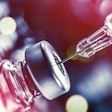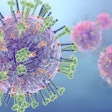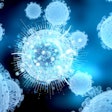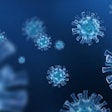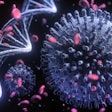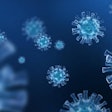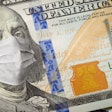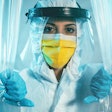
If you had the chance to do it all over again, what would you do differently? Representatives from clinical labs pondered that question as it relates to the COVID-19 pandemic in a December 14 session at the American Association for Clinical Chemistry (AACC) virtual meeting, offering guidance on how labs could respond to the next global health emergency.
It's not a matter of if but when the next global emergency happens, and there's a lot of room for improvement the next time around, using lessons learned from the experience with SARS-CoV-2 in 2020, advised Matthew Binnicker, PhD, director of clinical virology at the Mayo Clinic.
There is a need for the U.S. to prepare for the next pandemic just as it would for the next military conflict, Binnicker said. Resources must be ready to deploy as part of a national, coordinated strategy enabling widespread availability of polymerase chain reaction (PCR) testing in the early stage of an outbreak to prevent broad community transmission, the clinician explained during a morning panel session on pandemic preparedness at the AACC meeting, which is being held in a virtual format this year from December 13-17.
The role of the U.S. Centers for Disease Control and Prevention (CDC) and the World Health Organization (WHO) includes early identification of novel global emergency disease outbreaks and taking the lead on test development. The next time around, these agencies should involve select diagnostics manufacturers early in the assay design process and get industry ready to produce reagents in large quantities, he advised.
"I never would have thought I would be dealing with supply chain issues as much as I have in 2020," Binnicker said.
Public health laboratories are crucial for disease surveillance and have access to specimens necessary for validation of new tests, while clinical laboratories are closest to the patients and in prime position to diagnose cases in communities. Governments are capable of stockpiling supplies and determining where they are needed, as well as providing funding for testing.
"If there has been one key takeaway from this year [it] is that we must build strong partnerships between public health agencies, clinical laboratories, diagnostic test manufacturers, and government so that we can not only end the COVID-19 pandemic, but prepare ourselves for the next pandemic," Binnicker said.
Labs across the country should be trained for future pandemics and tests should be widely available from those that are qualified within two to four weeks of the first emergency use authorization (EUA) granted by the U.S. Food and Drug Administration (FDA), said Binnicker. noting that this is a lofty but achievable goal.
"We can't wait until a virus is well entrenched in society for the majority of clinical laboratories to have the ability to perform testing," he said.
EUAs put the brakes on lab testing
Binnicker and other panelists shared the experiences and many challenges of their own laboratories in 2020. With 15 confirmed cases in the U.S. in mid-February, the Mayo Clinic decided to quickly develop its own diagnostic, which received an EUA on April 21. By November, more than 2.6 million tests had been conducted.
But the complexities of the FDA's EUA process and ongoing supply shortages caused interruptions to lab testing workflow. These were among the biggest challenges for the Mayo Clinic.
Initially, the only test with an EUA was an assay developed at the CDC, and when it was distributed it became clear that the products were faulty. Meanwhile, labs were banned from running their own laboratory developed tests (LDTs) without an EUA, said panelist Morgan Pence, PhD, director of clinical and molecular microbiology at the Cook Children's Medical Center in Fort Worth, TX.
Pence's hospital, which is a 430-bed pediatric care facility, did not have the instrumentation needed to run the CDC test per the EUA granted by the FDA and started sending its cases out to a public health laboratory, which quickly became overloaded. Turnaround time in mid-March for coronavirus results ranged from 10 to 14 days, Pence recalled, and the hospital then found another lab that could get results back in from four to 10 days, which was better but still too long.
The EUA requirements were more stringent than CLIA, and the process for getting an EUA was too onerous for the staff to manage, so the hospital wound up waiting for commercial assays to come to market in order to offer in-house testing. Community hospitals began offering serology testing because the results were available fast, but accuracy was called into question amid a lack of oversight by the FDA.
In early April, Pence's center became the first community hospital in its area to offer PCR testing and began grappling with shortages of reagents. At the time, the facility was running from 10 to 15 tests a day, which "seems laughable now" but at the time it was really exciting to perform so many tests in-house with results back the same day or the next day, she said.
The Cook Children's Medical Center went on to cross-train technicians in molecular testing and in November acquired a new high-throughput instrument that enabled it to conduct batch testing three times daily. The FDA ultimately did allow labs to create their own LDTs without needing an EUA, but that was months later.
"We learned early on that EUA regulations for lab tests are prohibitive and really slowed labs down from implementing testing," Pence said.
"Thankfully the FDA has recognized that ... it was unfortunately too late for many labs," she added.
Labs still need oversight to ensure a high standard of testing, panelist Kirsten St. George, PhD, lab chief of the Wadsworth Center public health laboratory in the state of New York, cautioned during a question-and-answer period at the AACC session. There have been serious issues with lab-developed coronavirus tests submitted to the FDA, she said. However, the regulatory process needs to be streamlined and backed up with sufficient staff, St. George said.
Binnicker said that he agrees that the need to get tests out quickly needs to be balanced with streamlined regulatory oversight.
Reference labs expanded capacity and greatly helped community hospitals, but faster turnaround times were needed as well as testing closer to patients to really be effective, Pence said. As the pandemic went on and tests became more available, Pence said that she optimistically expected supply issues would ease, but instead demand soared and supply chain issues have persisted.
Early in the pandemic, the Wadsworth Center, which St. George said is the largest laboratory in the U.S. aside from the CDC, developed its own test in addition to using the agency's assay. The Wadsworth labs have been conducting tests on 1,000 specimens a day for coronavirus, compared with 400 per day for the Zika virus outbreak, and 200 per day for the flu pandemic in 2009. At the peak of the coronavirus pandemic, 2,600 specimens per day were tested, meaning little else could be done. The virology lab increased its number of scientists from 29 to 130 and additional laboratories were added.
As of the end of October, a total of 174,493 coronavirus tests had been conducted, of which 10,130 were positive, St. George noted.
"Testing capacity expanded beyond anything we ever expected," she said.








